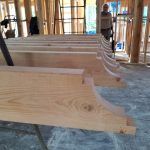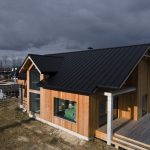
Improving Air Quality with Proper Kitchen Ventilation
One of the most overlooked yet essential aspects of any kitchen remodeling project is ventilation. Good kitchen ventilation in remodeling ensures that cooking fumes, moisture, and airborne grease are effectively removed from the space. Without it, your home could suffer from lingering odors, excess humidity, and even health risks.
Effective kitchen ventilation in remodeling involves using exhaust hoods, duct systems, and sometimes auxiliary ventilation methods to maintain a clean and healthy indoor environment. Ventilation not only protects your kitchen surfaces and cabinetry from damage caused by heat and moisture, but also helps maintain a comfortable atmosphere for everyone in the home.
Health and Safety Benefits of Kitchen Ventilation
Reduces Indoor Air Pollutants
Cooking releases various airborne pollutants, including carbon monoxide and nitrogen dioxide. Proper kitchen ventilation in remodeling ensures that these harmful gases are safely vented out of the home.
Minimizes Allergens and Odors
Kitchen ventilation systems help eliminate smoke, food odors, and potential allergens, keeping your indoor air fresh and healthy. This is especially important for households with pets or residents with asthma and other respiratory issues.
Prevents Mold and Mildew
By controlling humidity and moisture levels, good kitchen ventilation in remodeling helps prevent mold and mildew growth. This protects both your family’s health and the integrity of your kitchen’s structure and finishes.
Key Ventilation Systems to Consider
Range Hoods
Range hoods are the cornerstone of kitchen ventilation in remodeling. They capture and expel smoke, steam, and odors directly from your cooking surface. Available in ducted and ductless models, they also come in a variety of styles to match your kitchen’s design.
Ducted vs. Ductless Systems
- Ducted ventilation: Vents air outside the home and is generally more effective.
- Ductless systems: Filter and recirculate air, but are easier to install where external venting isn’t feasible.
Choosing the right system depends on your kitchen’s layout and your remodeling goals. Either way, prioritizing kitchen ventilation in remodeling is non-negotiable for a healthier home.
Supplemental Ventilation
In addition to range hoods, other systems like ceiling exhaust fans and make-up air systems may be recommended to support overall air circulation.
Energy Efficiency and Cost Savings
Kitchen ventilation in remodeling isn’t just about comfort and health—it can also impact your utility bills. A well-designed ventilation system can:
- Improve HVAC efficiency by reducing strain on your home’s heating and cooling systems
- Help maintain consistent indoor temperatures
- Reduce the need for frequent deep cleaning due to grease buildup
While high-end systems may require a larger upfront investment, the long-term energy savings and extended lifespan of your kitchen finishes can make them worthwhile.
Design Considerations for Ventilation
A common myth is that kitchen ventilation in remodeling ruins your kitchen’s aesthetic. In reality, modern ventilation systems are designed to blend in beautifully with your cabinetry, countertops, and overall layout. Sleek range hoods, custom enclosures, and integrated lighting options allow you to prioritize functionality without compromising style.
When planning your remodel, work with professionals who understand how to incorporate kitchen ventilation in remodeling while maintaining your design vision.
Let Mazzamuto Construction Handle the Air You Breathe
At Mazzamuto Construction, we believe that beautiful kitchens should also be breathable. Our remodeling experts prioritize proper kitchen ventilation in remodeling to deliver a safer, more efficient, and stylish space. Let’s talk about your remodel—schedule your consultation today.
Frequently Asked Questions (FAQ)
1. Is kitchen ventilation required by code?
In most areas, yes. Local building codes typically require kitchen ventilation, especially in homes with gas ranges. Always check with your contractor to ensure compliance.
2. What type of ventilation is best for my kitchen?
A ducted range hood is usually the most effective. However, ductless options can work well in smaller spaces or where exterior venting isn’t possible.
3. How often should I clean my range hood filter?
Ideally, clean it every 1-3 months, depending on how often you cook. Reusable metal filters can be washed, while charcoal filters in ductless systems need replacement.
4. Can I install a ventilation system myself?
While some ductless systems are DIY-friendly, we recommend professional installation to ensure proper function and code compliance.
5. How does ventilation affect home resale value?
Proper ventilation is a desirable feature that can make your kitchen more appealing to buyers, especially those concerned with indoor air quality.
Key Takeaways
- Kitchen ventilation in remodeling is crucial for air quality, health, and safety.
- Range hoods and exhaust systems reduce pollutants, odors, and moisture buildup.
- Energy efficiency and longevity of finishes improve with proper ventilation.
- Stylish and effective ventilation options are available for every kitchen design.
- Professional planning ensures ventilation works seamlessly with your remodel.




